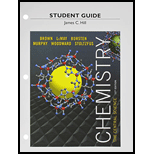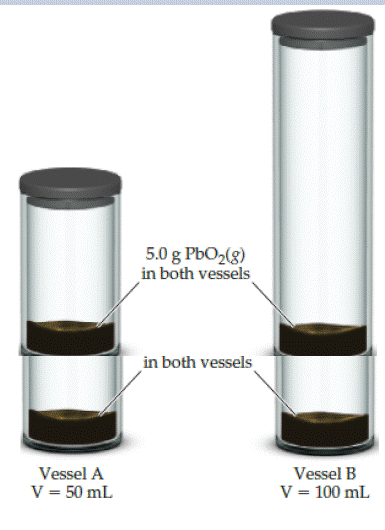
Study Guide for Chemistry: The Central Science
13th Edition
ISBN: 9780321949288
Author: Theodore E. Brown, James C. Hill
Publisher: PEARSON
expand_more
expand_more
format_list_bulleted
Textbook Question
Chapter 23, Problem 37E
When lead(IV) oxide is heated above 300 O C, it decomposes according to the following reaction PbO2(s) ⇌ PbO(s) + O2(g). Consider the two sealed vessels of PBO2 shown here. If both vessels are heated to 400 O C and allowed to come to equilibrium, which of the following statements is true?
- There will be less PbO2 remaining in vessel A,
- There will be less PbO2 remaining in vessel B,
- The amount of PbO2 remaining in each vessel will be the same.
[Section 15.4]

Expert Solution & Answer
Want to see the full answer?
Check out a sample textbook solution
Students have asked these similar questions
can you help me solve and highlight these hw
can you please help me draw these structures for HW
can you please help me draw these two structures , it is homework
Chapter 23 Solutions
Study Guide for Chemistry: The Central Science
Ch. 23.2 - Prob. 23.1.1PECh. 23.2 - Prob. 23.1.2PECh. 23.2 - Prob. 23.2.1PECh. 23.2 - Prob. 23.2.2PECh. 23.4 - The following mechanism has been proposed for the...Ch. 23.4 - Prob. 23.3.2PECh. 23.4 - Prob. 23.4.1PECh. 23.4 - Platinum nanoparticles of diameter ~2 nm are...Ch. 23.4 - 14.114 One of the many remarkable enzymes in the...Ch. 23.4 - 14.115N Suppose that, in the absence of catalyst,...
Ch. 23.5 - Prob. 23.6.1PECh. 23.5 - Dinitrogen pentoxide (N2O5) decomposes in...Ch. 23.6 - The reaction between ethyl iodide and hydroxide...Ch. 23.6 - Prob. 23.7.2PECh. 23.6 - Prob. 23.8.1PECh. 23.6 - Prob. 23.8.2PECh. 23 - Prob. 1DECh. 23 - Practice Exercise 1
If 8.0 g of NH4HS(s)...Ch. 23 - Practice Exercise 1 For the reaction 4 NH3(g) + 5...Ch. 23 - Prob. 3ECh. 23 - Prob. 4ECh. 23 - Phosphorus trichloride gas and chlorine gas react...Ch. 23 - Prob. 6ECh. 23 - Prob. 7ECh. 23 - 15.70 True or false: When the temperature of an...Ch. 23 - Prob. 9ECh. 23 - Prob. 10ECh. 23 - Prob. 11ECh. 23 - Prob. 12ECh. 23 - Prob. 13ECh. 23 - Prob. 14ECh. 23 - Prob. 15ECh. 23 - Practice Exercise 2 For the reaction H2 (g) + I2...Ch. 23 - Prob. 17ECh. 23 - Prob. 18ECh. 23 - Prob. 19ECh. 23 - Practice Exercise 1
A mixture of gaseous sulfur...Ch. 23 - Prob. 21ECh. 23 - Prob. 22ECh. 23 - Practice Exercise 2
The gaseous compound BrCl...Ch. 23 - Prob. 24ECh. 23 - Practice Exercise 2 At 1000 k, the value of Kp for...Ch. 23 - Prob. 26ECh. 23 - Prob. 27ECh. 23 - Practice Exercise 1 For the equilibrium Br2(g) +...Ch. 23 - Prob. 29ECh. 23 - Prob. 30ECh. 23 - Prob. 31ECh. 23 - Prob. 32ECh. 23 - Prob. 33ECh. 23 - Prob. 34ECh. 23 - Prob. 35ECh. 23 - 15.6 Ethene (C2H4) reacts with healogens (X2) by...Ch. 23 - When lead(IV) oxide is heated above 300 O C, it...Ch. 23 - Prob. 38ECh. 23 - The reactin A2(g) + B(g) + A(g) + AB(g) has an...Ch. 23 - The following graph represents the yield of the...Ch. 23 - Suppose that the gas-phase reactions A B and B A...Ch. 23 - Prob. 42ECh. 23 - Prob. 43ECh. 23 - Prob. 44ECh. 23 - Prob. 45ECh. 23 - Prob. 46ECh. 23 - Prob. 47ECh. 23 - Prob. 48ECh. 23 - Prob. 49ECh. 23 - Prob. 50ECh. 23 - Prob. 51ECh. 23 - Prob. 52ECh. 23 - Prob. 53ECh. 23 - Prob. 54ECh. 23 - Prob. 55ECh. 23 - Prob. 56ECh. 23 - Prob. 57ECh. 23 - Prob. 58ECh. 23 - For each of the following metals, write the...Ch. 23 - Prob. 60ECh. 23 - Prob. 61ECh. 23 - Prob. 62ECh. 23 - Prob. 63ECh. 23 - Prob. 64ECh. 23 - Prob. 65AECh. 23 - Prob. 66AECh. 23 - Prob. 67AECh. 23 - Prob. 68AECh. 23 - Prob. 69AECh. 23 - Prob. 70AECh. 23 - Prob. 71AECh. 23 - Prob. 72AECh. 23 - Prob. 73AECh. 23 - Prob. 74AECh. 23 - Prob. 75AECh. 23 - Prob. 76AECh. 23 - Prob. 77AECh. 23 - Prob. 78AECh. 23 - Prob. 79AECh. 23 - Prob. 80AECh. 23 - Prob. 81AECh. 23 - Prob. 82AECh. 23 - Prob. 83AECh. 23 - Prob. 84AECh. 23 - Prob. 85AECh. 23 - Prob. 86AECh. 23 - Prob. 87AECh. 23 - Prob. 88AECh. 23 - Prob. 89AECh. 23 - Prob. 90IECh. 23 - Prob. 91IECh. 23 - Prob. 92IECh. 23 - Prob. 93IECh. 23 - Prob. 94IECh. 23 - Prob. 95IECh. 23 - Prob. 96IECh. 23 - Prob. 97IECh. 23 - Prob. 98IECh. 23 - Prob. 99IECh. 23 - Prob. 100IECh. 23 - Prob. 101IE
Knowledge Booster
Learn more about
Need a deep-dive on the concept behind this application? Look no further. Learn more about this topic, chemistry and related others by exploring similar questions and additional content below.Similar questions
- please help with synthesisarrow_forward10. Stereochemistry. Assign R/S stereochemistry for the chiral center indicated on the following compound. In order to recieve full credit, you MUST SHOW YOUR WORK! H₂N CI OH CI カー 11. () Stereochemistry. Draw all possible stereoisomers of the following compound. Assign R/S configurations for all stereoisomers and indicate the relationship between each as enantiomer, diastereomer, or meso. NH2 H HNH, -18arrow_forwardb) 8. Indicate whether the following carbocation rearrangements are likely to occur Please explain your rational using 10 words or less not likely to occur • The double bond is still in the Same position + Likely to oc occur WHY? -3 H3C Brave Chair Conformers. Draw the chair conformer of the following substituted cyclohexane. Peform a RING FLIP and indicate the most stable conformation and briefly explain why using 20 words or less. CI 2 -cobs ?? MUST INDICATE H -2 -2 Br EQ Cl OR AT Br H& most stable WHY? - 4arrow_forward
- CH 12 Conformational Analysis. Draw all 6 conformers (one above each letter) of the compound below looking down the indicated bond. Write the letter of the conformer with the HIGHEST and LOWEST in energies on the lines provided. NOTE: Conformer A MUST be the specific conformer of the structure as drawn below -4 NOT HOH OH 3 Conformer A: Br OH A Samo Br H 04 Br H H3 CH₂ H anti stagere Br CH clipsed H Brott H IV H MISSING 2 -2 B C D E F X 6 Conformer with HIGHEST ENERGY: 13. (1 structure LOWEST ENERGY: Nomenclature. a) Give the systematic (IUPAC) name structure. b) Draw the corresponding to this name. HINT: Do not forget to indicate stereochemistry when applicable. a) ८८ 2 "Br {t༐B,gt)-bemn€-nehpརི་ཚ༐lnoa Parent name (noname) 4 Bromo Sub = 2-methylethyl-4 Bromo nonane b) (3R,4S)-3-chloro-4-ethyl-2,7-dimethyloctane # -2 -2arrow_forwardin the scope of the SCH4U course! please show all steps as im still learning how to format my answers in the format given, thank you!arrow_forwardhelp me solve this HWarrow_forward
- Molecules of the form AH2 can exist in two potential geometries: linear or bent. Construct molecular orbital diagrams for linear and bent CH2. Identify the relevant point group, include all of the appropriate symmetry labels and pictures, and fill in the electrons. Which geometry would you predict to be more stable, and why? (Please draw out the diagram and explain)arrow_forwardIndicate the variation in conductivity with concentration in solutions of strong electrolytes and weak electrolytes.arrow_forwardThe molar conductivity of a very dilute solution of NaCl has been determined. If it is diluted to one-fourth of the initial concentration, qualitatively explain how the molar conductivity of the new solution will compare with the first.arrow_forward
arrow_back_ios
SEE MORE QUESTIONS
arrow_forward_ios
Recommended textbooks for you
 Chemistry: The Molecular ScienceChemistryISBN:9781285199047Author:John W. Moore, Conrad L. StanitskiPublisher:Cengage Learning
Chemistry: The Molecular ScienceChemistryISBN:9781285199047Author:John W. Moore, Conrad L. StanitskiPublisher:Cengage Learning Chemistry & Chemical ReactivityChemistryISBN:9781337399074Author:John C. Kotz, Paul M. Treichel, John Townsend, David TreichelPublisher:Cengage Learning
Chemistry & Chemical ReactivityChemistryISBN:9781337399074Author:John C. Kotz, Paul M. Treichel, John Townsend, David TreichelPublisher:Cengage Learning General Chemistry - Standalone book (MindTap Cour...ChemistryISBN:9781305580343Author:Steven D. Gammon, Ebbing, Darrell Ebbing, Steven D., Darrell; Gammon, Darrell Ebbing; Steven D. Gammon, Darrell D.; Gammon, Ebbing; Steven D. Gammon; DarrellPublisher:Cengage Learning
General Chemistry - Standalone book (MindTap Cour...ChemistryISBN:9781305580343Author:Steven D. Gammon, Ebbing, Darrell Ebbing, Steven D., Darrell; Gammon, Darrell Ebbing; Steven D. Gammon, Darrell D.; Gammon, Ebbing; Steven D. Gammon; DarrellPublisher:Cengage Learning Chemistry & Chemical ReactivityChemistryISBN:9781133949640Author:John C. Kotz, Paul M. Treichel, John Townsend, David TreichelPublisher:Cengage Learning
Chemistry & Chemical ReactivityChemistryISBN:9781133949640Author:John C. Kotz, Paul M. Treichel, John Townsend, David TreichelPublisher:Cengage Learning Chemistry: Principles and PracticeChemistryISBN:9780534420123Author:Daniel L. Reger, Scott R. Goode, David W. Ball, Edward MercerPublisher:Cengage Learning
Chemistry: Principles and PracticeChemistryISBN:9780534420123Author:Daniel L. Reger, Scott R. Goode, David W. Ball, Edward MercerPublisher:Cengage Learning ChemistryChemistryISBN:9781305957404Author:Steven S. Zumdahl, Susan A. Zumdahl, Donald J. DeCostePublisher:Cengage Learning
ChemistryChemistryISBN:9781305957404Author:Steven S. Zumdahl, Susan A. Zumdahl, Donald J. DeCostePublisher:Cengage Learning

Chemistry: The Molecular Science
Chemistry
ISBN:9781285199047
Author:John W. Moore, Conrad L. Stanitski
Publisher:Cengage Learning

Chemistry & Chemical Reactivity
Chemistry
ISBN:9781337399074
Author:John C. Kotz, Paul M. Treichel, John Townsend, David Treichel
Publisher:Cengage Learning

General Chemistry - Standalone book (MindTap Cour...
Chemistry
ISBN:9781305580343
Author:Steven D. Gammon, Ebbing, Darrell Ebbing, Steven D., Darrell; Gammon, Darrell Ebbing; Steven D. Gammon, Darrell D.; Gammon, Ebbing; Steven D. Gammon; Darrell
Publisher:Cengage Learning

Chemistry & Chemical Reactivity
Chemistry
ISBN:9781133949640
Author:John C. Kotz, Paul M. Treichel, John Townsend, David Treichel
Publisher:Cengage Learning

Chemistry: Principles and Practice
Chemistry
ISBN:9780534420123
Author:Daniel L. Reger, Scott R. Goode, David W. Ball, Edward Mercer
Publisher:Cengage Learning

Chemistry
Chemistry
ISBN:9781305957404
Author:Steven S. Zumdahl, Susan A. Zumdahl, Donald J. DeCoste
Publisher:Cengage Learning
Chemical Equilibria and Reaction Quotients; Author: Professor Dave Explains;https://www.youtube.com/watch?v=1GiZzCzmO5Q;License: Standard YouTube License, CC-BY